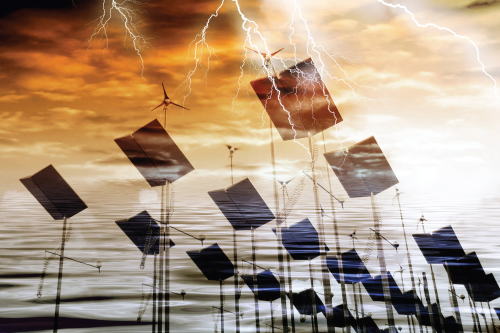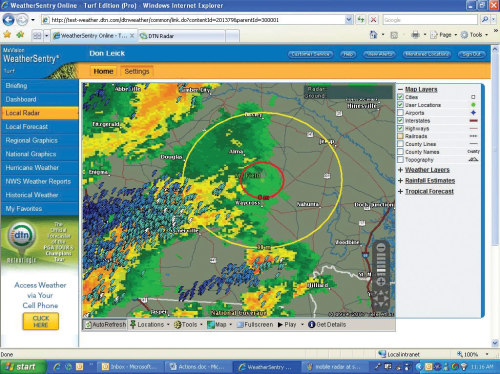

Lightning safety is a key concern for maintenance crews at wind farms, most of which are located in wide open, lightning-prone areas and are surrounded by turbine structures hundreds of feet high. While all tall structures are prone to lightning strikes because they provide a conductive channel to the ground, some experts believe wind turbines carry a particularly high risk.
Lightning Flash versus Stroke |
|
A complete lightning discharge is known as a ‘flash’ while the high-current pulses in a flash are known as ‘strokes’. Strokes can travel down the same channel or have different ground contact points. Typical flashes have three or four strokes. Does Polarity Matter?A cloud-to-ground lightning stroke can lower positive or negative charge to the ground. More than 90% of lightning is negatively charged but the less common positive strokes typically have larger peak currents that can increase the probability of asset damage or fires. |
Evacuating the tower and driving away from the wind farm is the ultimate safety goal, but the height of wind turbines means it takes a considerable amount of time to get safely to the ground. It is important, therefore, to have significant advance notice of potential lightning strikes.
A system that detects lightning and also has the ability to provide alerts to on-site maintenance crews is one proven way to keep wind farm employees safe. Wind energy organizations that have on-site maintenance staff – including operators, turbine manufacturers and contract maintenance crews – typically have well-established lightning safety practices.
However, there are still various misguided practices that are ineffective and highly dangerous:
- Watching for lightning and listening for thunder: Lightning strikes can occur miles away from a storm. Relying on your senses instead of adhering to advanced warnings allows lightning to strike before there is adequate time to respond;
- Monitoring radar images and guessing: This method for tracking lightning using computers or phones produces two opposite and undesirable results – false alarms and unidentified lightning in the area; and
- Delayed lightning information online: The average life of a thunderstorm cell is 20 minutes and lightning information from free websites is delayed by up to an hour. Lightning can be on top of you before it shows up on the site. When crew member safety is on the line, it is worth the price of subscribing to a service that provides real-time updates.
The misguided lightning safety approaches above lead wind farm operators to gamble with lives. Instead, they should rely on a combination of real-time lightning detection networks with immediate alerting capabilities, and all-clear notifications, as an effective technique for keeping their personnel safe and ensuring their operations go smoothly.
Making Safety a Top Priority
Constantly monitoring approaching thunderstorms and tracking lightning activity can be a burden; wind farm operators cannot afford to cut corners but at the same time they cannot spend their time glued to a weather map. To effectively observe impending lightning, wind farm personnel should use a real-time weather service that allows them to program alert parameters set specifically to meet their needs.
Determining the alert radius can depend on the amount of time it takes to climb down the tower and get to the safety of a truck (with the windows closed and ensuring your body is not in contact with the metal chassis).
There are two alerts essential for notifying wind farm crews that lightning is moving into the area:
- Heads-up alert: Many wind farms set this alert to go off when lightning is within 50 or 60 miles of the farm. It puts crews on notice that severe weather has entered the area and they should be on heightened alert; and
- Evacuation alert: Once lightning gets closer, an evacuation alert should be broadcast. A typical parameter for evacuating a wind farm is 30 miles.
Once a storm has entered the area, wind farm operators need to determine when operations can return to normal. Figuring out how to get crews back into the field without putting them in danger is a delicate task.
Receiving an ‘all-clear’ alert is an effective way of maximizing productivity while ensuring employee safety. It is common practice to send crews back when there has been no lightning within 30 miles of the workplace for a period of 15 minutes. Some operators are extra-cautious and wait until lightning has been absent within a radius of 60 miles for 15 minutes.
Real Time Weather Information
In addition to advanced alerting capabilities, wind farm operators can greatly benefit from maps that display real-time lightning data. A visualization of lightning activity combined with radar can provide a good sense of when storms are approaching. This holds especially true when a second line of storms is developing that has not yet entered the warning parameter.
This function is very helpful for maintenance scheduling, as operators can avoid starting activities that may have to be suspended due to bad weather. Pairing these detailed weather maps with animated lightning strike data shows whether lightning is intensifying or subsiding.
Although crews should be responsible first and foremost for their own safety, centralized monitoring can act as a backup for field personnel.
Employees at a central facility can monitor weather activity in proximity to wind farms and can call crews about impending weather issues.
The ability to view forthcoming and current lightning activity is crucial for maintaining safety on a wind farm but it is also important to look back at recent lightning activity in the area to allow more preventative measures. Services from companies such as Telvent (see box) provide access to detailed data for previous days and can archive it for future reference. This allows operators to document, analyze and report on lightning activity in the area for planning, analysis, damage assessment and insurance claims.
Implementing a complete operational weather solution is also a cost-effective way of managing crew scheduling and reducing maintenance costs.
These systems are easy to implement and manage, and allow wind farm operators to mitigate weather disasters.
Case Study: Langdon Wind Energy Center |
|
The Langdon Wind Energy Center, owned by NextEra Energy Resources, operates a 40-acre wind farm in North Dakota. It has 133 wind turbines that can produce a total power capacity of 199.5 MW. To ensure the wind turbines are operating at maximum efficiency, a team of 12 technicians perform routine maintenance and are on-call 24 hours a day in case of an emergency. Located in the Upper Midwest region of the US, North Dakota’s flat plains and strong, steady winds make it the ideal location for a wind farm. But this part of the country is particularly susceptible to extreme weather conditions; summer brings the very real threat of lightning strikes to the 300-foot tall wind turbines, and brutally cold temperatures are common in the winter. “In addition to lightning risks, we don’t send out crews if it’s colder than 28 degrees below zero Celsius,” says Bill Campbell, plant leader for Langdon Wind Energy Center. “In cases of extreme cold, we only send out crews when absolutely necessary.” To help navigate through these weather challenges, the center subscribes to Telvent’s MxVision WeatherSentry, an online tool for wind energy professionals. By accessing an internet-based platform, the center is able to stay on top of changing weather conditions that endanger and impact their operations. For a broad view of approaching severe weather, Langdon Wind Energy Center monitors radar and tracks storms, wind and lightning on one centralized online dashboard. The dashboard features a weather map with layers that allow personnel to look at information that is relevant to its operations. This includes National Weather Service (NWS) warnings, watches and advisories. Another layer includes custom areas of maximum impact based on parameters set by the center itself, to reflect how weather is affecting the exact location of its turbines. In addition to the online dashboard, the center uses a mobile alert system to view current and future conditions. In order to remain one step ahead of the weather, employees have access to all the online dashboard’s weather information on their mobile phones as well. Additionally, personalized alerts are sent instantly to employees’ phones when severe weather nears userdefined alerting parameters. This is especially important for field technicians performing maintenance tasks. “We let the technicians know when lightning has been detected within 60 miles,” says Campbell. “When lightning is detected within 30 miles, we require our crews to evacuate the turbines.” The mobile alerts are fed from an alert manager that provides instant notification of significant weather changes within their coverage area. When weather conditions such as wind speed change or when the NWS issues a watch, warning or advisory, an audible alarm is triggered to go off through the online dashboard. “Our system alerts us by sounding a siren. This lets us know that we need to either monitor weather conditions more closely or evacuate crews,” says Campbell. The most critical weather component for Langdon Wind Energy Center is the ‘lightning manager’. Receiving advanced warning of real-time lightning strikes from real-time data is much safer than predictions, which can lead to false alarms or delayed reporting after lightning has already struck. Five Langdon crew members use the system to access weather data in the office, on the wind farm and at home. “If my guys get called in over the weekend, I can log on from home to find out what’s going on with the weather and ensure their safety,” says Campbell. In addition to watching storms as they pass through the area, Campbell and his technicians use a mix of hourly and 10-day forecasts to schedule routine maintenance. This allows for more efficient planning; for example, a wind turbine should not be cleaned during a rain storm. Although this type of renewable energy relies on wind to generate electricity, too much wind can impact operations and safety. If winds are too strong, crews cannot work on the turbine’s hub. Although each turbine has a wind speed indicator on it, Langdon Wind Energy Center also relies on Telvent’s software for wind speed and direction to ensure optimal safety. Overall, the ability to access a variety of weather information quickly and reliably has been highly beneficial at Langdon. “Safety is a shared value at our company,” says Campbell. “We rely heavily on real-time weather information to keep our technicians safe and operations running efficiently.” |
About the Author:
Don Leick is Product Management Director at Telvent DTN commercial weather services.





